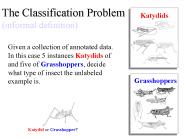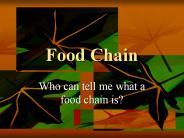Grasshoppers PowerPoint PPT Presentations
All Time
Recommended
The Classification Problem (informal definition) Katydids Given a collection of annotated data. In this case 5 instances Katydids of and five of Grasshoppers, decide ...
| PowerPoint PPT presentation | free to download
... Looking for new candidate genes for mating behaviour and speciation ... 253-284 sibling species morphologically and genetically very similar parapatric ...
| PowerPoint PPT presentation | free to view
Title: Slide 1 Author: latchini Last modified by: sonjas Created Date: 4/5/2006 4:56:00 PM Document presentation format: On-screen Show Company: University of Wyoming
| PowerPoint PPT presentation | free to view
Cambodia: take several dozen locust adults, preferably females, slit the abdomen ... Then lightly grill the locusts in a wok or hot frying pan, adding a little oil ...
| PowerPoint PPT presentation | free to view
... low humidity discourage grasshopper diseases. Higher temperatures ... Nosema locustae Nolo Bait , Grasshopper Attack Large acreages; 40-50 percent control ...
| PowerPoint PPT presentation | free to view
She could not see her face in the mirror because it was so dull. Not bright or clear ... The zebra was sensing danger when it heard the roar of the lion. antennae ...
| PowerPoint PPT presentation | free to download
Incomplete Metamorphosis Sucking insects (Order Hemiptera) Cockroach (Order Blattodea) Termites (Order Isoptera) Lice (Order Phthiraptera)
| PowerPoint PPT presentation | free to download
Grasshoppers. Katydids. The Classification Problem (informal definition) ... Grasshoppers. Katydids. Abdomen Length ... Grasshoppers ...
| PowerPoint PPT presentation | free to view
ORTHOPTERA (grasshoppers, crickets, katydids) Characteristics of Orthoptera. 1. ... Gryllidae - crickets, mole crickets. Orthoptera. Number of Species. Common names ...
| PowerPoint PPT presentation | free to view
Grasshoppers have 24 chromosomes, arranged in 12 pairs. Each of a grasshopper's sex cells contains 12 chromosomes, or half the number in body cells. ...
| PowerPoint PPT presentation | free to view
Grasshopper. Grasshoppers can be. very destructive to. vegetation by eating the. leaves. ... Grasshoppers. detect sounds using a. membrane called a. tympanum ...
| PowerPoint PPT presentation | free to view
Types of Mouthparts. Chewing - grasshoppers, beetles. Piercing - mosquitoes, ... Grasping - preying mantis. Jumping - fleas, grashoppers. Digging - mole cricket ...
| PowerPoint PPT presentation | free to view
Is your garden an island in a sea of grasshoppers? Scott Schell & Alex Latchininsky Grasshopper in Gardens Twostriped grasshopper facts Peak hatch May 15 to June 15 ...
| PowerPoint PPT presentation | free to download
That is the Grasshopper's. He takes the lead. In summer luxury; he has never done ... The Grasshopper's among some grassy hills. Notes on John Keats ...
| PowerPoint PPT presentation | free to view
Order Araneida ( spiders) Class Trilobita ( Ancient Trilobites) ... ( grasshoppers, katydids, crickets, camel crickets, walking sticks, praying mantids and roaches) ...
| PowerPoint PPT presentation | free to view
Food Chain Who can tell me what a food chain is? According to this food web, which of the following are omnivores? A Snakes B Rabbits C Mice D Grasshoppers The ...
| PowerPoint PPT presentation | free to download
Subject-Verb Agreement ... Practice (Present Tense) The iguana _____ (to drink) the water. The grasshoppers _____ (to hop) away from the iguana.
| PowerPoint PPT presentation | free to view
Rodents. Birds. Rabbits. Fruit. Vegetables. Bird Seed. Insects/grasshoppers. Garbage food scraps ... Rodent population significantly increases. Coyote Awareness ...
| PowerPoint PPT presentation | free to view
Spider. Frog. Butterfly. Dinosaur. Next Slide. Grasshoppers eat plants ... Dinosaurs , mainly, eat plants: leaves, ferns, moss, but not grass. Herbivore. Back ...
| PowerPoint PPT presentation | free to view
... common ones are: ants, butterflies, moths, bees, beetles, grasshoppers, fleas, ... Butterflies. Moths. Social Grouped Insects... Ants. Bees. Grounded ...
| PowerPoint PPT presentation | free to view
Lepidoptera Hint: We d love to catch a leopard-spotted butterfly. A. Orthoptera Hint: Grasshoppers love to hop! Remember the word hop in the name. * *
| PowerPoint PPT presentation | free to download
Grasshoppers, mosquitoes, ladybugs, bees, butterflies, ants, etc. ... virtually unchanged over the past 500 ... Spiracles openings to the outside of the body ...
| PowerPoint PPT presentation | free to view
Microclimate: Small scale weather variation, ... Sun Basking. Grasshoppers ... muscles of many fish (Mackerel, Sharks, Tuna) are well supplied with blood ...
| PowerPoint PPT presentation | free to view
Macroclimate: Large scale weather variation. ... Sun Basking. Grasshoppers ... muscles of many fish (Mackerel, Sharks, Tuna) are well supplied with blood ...
| PowerPoint PPT presentation | free to view
The number of individuals in a population is its size. ... Animals : mice, rabbits, raccoon, deer, cougar, bear, quail, bobcat, grasshoppers, snake ...
| PowerPoint PPT presentation | free to view
Bees, butterflies, flies. Herbivores. Caterpillars!, aphids, grasshoppers, ants, sawflies ... Wasps, flies. Predators. Wasps, ants. FM-324:Forest Entomology ...
| PowerPoint PPT presentation | free to view
Grasshopper. Soybean defoliators. Oklahoma State University. Fall armyworm/corn earworm: ... Grasshoppers may be more of a problem in conservation tillage ...
| PowerPoint PPT presentation | free to view
observed gamete formation and karyotype in lubber grasshoppers ... Role in life cycle reproduction gamete production in in unicellular, sexually ...
| PowerPoint PPT presentation | free to view
This device works on almost all kinds of pests, bugs, and animals. Cockroaches, bats, mouse, spiders, moths, grasshoppers, bush-crickets, crickets, frogs, birds are just to name a few.
| PowerPoint PPT presentation | free to download
... grow and become an adult, young insects shed or molt their ... In grasshoppers, the young resemble the adults. The younger stages are called nymphs. ...
| PowerPoint PPT presentation | free to view
They can be brown, black, orange, pink, yellow or dull white. They can be 18 inches long. ... like flies, spiders, and grasshoppers. Opossums look like fur coat, ...
| PowerPoint PPT presentation | free to view
Favorite snacks-insects(anything from grubs and beatles to grasshoppers ... Good swimmers(doggie paddle) Doesn't usaly run but if it has to, can run up to 9 mi. ...
| PowerPoint PPT presentation | free to view
ARTHROPODS BIOLOGY PROGRAM MOUNTAIN POINTE HIGH SCHOOL Animals of Phylum Arthropoda Termites, ticks, scorpions, grasshoppers, flies, mosquitoes, lobsters, crabs, bugs ...
| PowerPoint PPT presentation | free to view
Grasshopper: Has a chewing mouth. Some butterflys: Have a long 'hose' for sucking nectar ... Examples are grasshoppers and crickets. http://www.ent.iastate.edu ...
| PowerPoint PPT presentation | free to download
Polar Grasslands, better known as Tundra, are a biome that cover 10% of the earth ... Insects: Mosquitoes, flies, arctic bumble bees, grasshoppers. Diversity ...
| PowerPoint PPT presentation | free to view
Some may be very large like: The deserts of Africa. The rain forest of Brazil ... the foxes, dandelions, grasshoppers, snakes, hawks, deer, and skunks living in ...
| PowerPoint PPT presentation | free to view
The grasshopper Gastrimargus africanus can match its color to that of its surroundings: ... grasshoppers foraging on mixed diets grow faster than those fed a ...
| PowerPoint PPT presentation | free to download
Blood is pumped into the body cavity where it surrounds all of ... Found in invertebrates like grasshoppers. Grasshopper Open System. Closed Circulatory System ...
| PowerPoint PPT presentation | free to view
... of the following is one reason that an animal may ... mice. grasshoppers. cactus. A. Most food chains start with: an animal. a mouse. a plant. the ocean. C ...
| PowerPoint PPT presentation | free to download
Madagascar is in the Indian Ocean. The most recent estimate population is ... The Tailless Tenrec is 10-16' it's diet is worms, grubs, grasshoppers, and other ...
| PowerPoint PPT presentation | free to view
D. grasshoppers. Virtual Academy for the Semi Arid Tropics. Module III ... The larvae in the picture are that of pink borer of sorghum. ...
| PowerPoint PPT presentation | free to view
... primarily with weed and grasshopper control, rabies vaccinations, and animal display licensing ... Asian Gypsy Moth, Grasshoppers/Crickets, Syrex Wasps ...
| PowerPoint PPT presentation | free to view
GRASSHOPPERS. SWALLOWS. FALCONS. DDT Sprayed on plants. 1 microgram (ug)/ plant. 10 ug/ grasshopper. 100 ug/ swallow. 1000 ug/ falcon. FOOD. PYRAMID ...
| PowerPoint PPT presentation | free to view
Still, it is generally agreed that all living things share certain ... Robins. Squirrels. Grasshoppers. Oak trees. Pine trees. Grasses. People. Etc. Species ...
| PowerPoint PPT presentation | free to view
moment of every day, we breathe air. Whatever you are doing, you are breathing. ... Insects, like grasshoppers, caterpillars, flies, moths and butterflies breathe ...
| PowerPoint PPT presentation | free to view
... whole before trying to understand the parts- grasshoppers rather than inchworms. ... to solving problems; the grasshopper makes intuitive leaps, jumping over ...
| PowerPoint PPT presentation | free to view
Used in Aglets, Grasshoppers, Mole, Discovery. Weak mobility with fixed method invocation ... Grasshopper. A method named live is invoked to an agent ...
| PowerPoint PPT presentation | free to view
A visit from the Sharon Audobon Society gives the children an up-close and ... Owls have very large eyes to see in the dark. Falcons like to eat grasshoppers. ...
| PowerPoint PPT presentation | free to view
Grasshoppers top the list as the insect most eaten by. many Africans and Venezuelans. ... Where are most insects eaten? What is the most popular insect? Grasshopper ...
| PowerPoint PPT presentation | free to view
... in 1902 was doing research on grasshopper chromosomes. ... Each of a grasshopper's sex cells. contains 12 chromosomes, or. half the number in body cells. ...
| PowerPoint PPT presentation | free to view
Digest food outside of their bodies and then absorb it ... lodge in grasshoppers and germinate and penetrate the grasshopper and slowly digest it ...
| PowerPoint PPT presentation | free to view
On a beautiful summer afternoon, Grasshopper lay on his back on a leaf, gazing ... This was Grasshopper's favorite thing to do all day, every day. ...
| PowerPoint PPT presentation | free to view
The state tree is the ponderosa pine; the bark of this tree was ... 1807-gold was then discovered at Grasshopper Creek, the home of billions of grasshoppers. ...
| PowerPoint PPT presentation | free to view
Edible Insects Market Size By Product (Beetles, Caterpillars, Grasshoppers, Bees, Wasps, Ants, Scale Insects & True Bugs), By Application (Flour, Protein Bars, Snacks), Industry Analysis Report, Regional Outlook (U.S., Belgium, Netherlands, UK, France, China, Thailand, Vietnam, Brazil, Mexico), Application Potential, Price Trends, Competitive Market Share & Forecast, 2016 – 2023
Edible insects such as caterpillars, bees, ants and wasps, beetles, scale insects, grasshoppers, crickets, locusts, and mealworm are fit for human consumption and do not produce any toxic effect. Additionally, edible insects are considered as a rich source of protein, vitamins, and amino acids, which has a wide range of application in the food & beverage and animal feed industry. Also, they do not produce toxic gases such as ammonia, which is harmful to the environment.
These damaged crops cause farmers to lose money. Fields can go. from ... Different kinds of flies are their greatest enemies, because they eat grasshopper eggs ...
| PowerPoint PPT presentation | free to view
























































